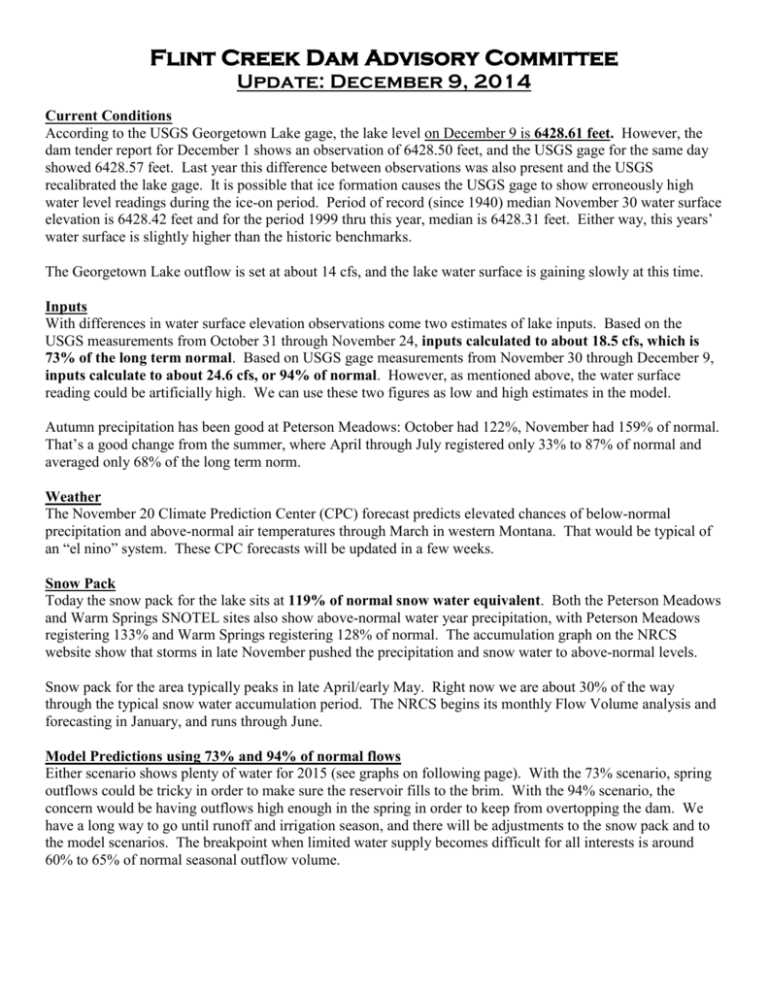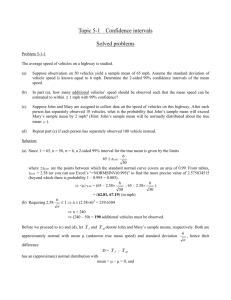Flint Creek Dam Advisory Committee Meeting
advertisement

Flint Creek Dam Advisory Committee Update: December 9, 2014 Current Conditions According to the USGS Georgetown Lake gage, the lake level on December 9 is 6428.61 feet. However, the dam tender report for December 1 shows an observation of 6428.50 feet, and the USGS gage for the same day showed 6428.57 feet. Last year this difference between observations was also present and the USGS recalibrated the lake gage. It is possible that ice formation causes the USGS gage to show erroneously high water level readings during the ice-on period. Period of record (since 1940) median November 30 water surface elevation is 6428.42 feet and for the period 1999 thru this year, median is 6428.31 feet. Either way, this years’ water surface is slightly higher than the historic benchmarks. The Georgetown Lake outflow is set at about 14 cfs, and the lake water surface is gaining slowly at this time. Inputs With differences in water surface elevation observations come two estimates of lake inputs. Based on the USGS measurements from October 31 through November 24, inputs calculated to about 18.5 cfs, which is 73% of the long term normal. Based on USGS gage measurements from November 30 through December 9, inputs calculate to about 24.6 cfs, or 94% of normal. However, as mentioned above, the water surface reading could be artificially high. We can use these two figures as low and high estimates in the model. Autumn precipitation has been good at Peterson Meadows: October had 122%, November had 159% of normal. That’s a good change from the summer, where April through July registered only 33% to 87% of normal and averaged only 68% of the long term norm. Weather The November 20 Climate Prediction Center (CPC) forecast predicts elevated chances of below-normal precipitation and above-normal air temperatures through March in western Montana. That would be typical of an “el nino” system. These CPC forecasts will be updated in a few weeks. Snow Pack Today the snow pack for the lake sits at 119% of normal snow water equivalent. Both the Peterson Meadows and Warm Springs SNOTEL sites also show above-normal water year precipitation, with Peterson Meadows registering 133% and Warm Springs registering 128% of normal. The accumulation graph on the NRCS website show that storms in late November pushed the precipitation and snow water to above-normal levels. Snow pack for the area typically peaks in late April/early May. Right now we are about 30% of the way through the typical snow water accumulation period. The NRCS begins its monthly Flow Volume analysis and forecasting in January, and runs through June. Model Predictions using 73% and 94% of normal flows Either scenario shows plenty of water for 2015 (see graphs on following page). With the 73% scenario, spring outflows could be tricky in order to make sure the reservoir fills to the brim. With the 94% scenario, the concern would be having outflows high enough in the spring in order to keep from overtopping the dam. We have a long way to go until runoff and irrigation season, and there will be adjustments to the snow pack and to the model scenarios. The breakpoint when limited water supply becomes difficult for all interests is around 60% to 65% of normal seasonal outflow volume. Dave Amman, Montana DNRC 444-6648 2014 REVIEW Outflows this past summer were held pretty closely to 30 cfs, with a few exceptions. In late May, outflow was temporarily held at 78 cfs to accommodate snow melt and high inflows. There were a few other blips up to 40 cfs in July, and outflow was reduced in late October for a dam inspection and/or hydroelectric tasks. Here are provisional monthly average outflows, along with historic period of record average mean outflows: April May June July 2014 32 cfs 43 cfs 48 cfs 31 cfs POR Mean 26 cfs 35 cfs 59 cfs 46 cfs Aug Sept Oct Nov 2014 31 cfs 31 cfs 27 cfs 20 cfs POR Mean 35 cfs 32 cfs 26 cfs 21 cfs The provisional instantaneous peak outflow was 82 cfs on June 7. For the period of record, the 2-year return interval peak is 83 cfs. For Boulder Creek at Maxville, an undammed stream, the peak was 356 cfs on May 29. The 2year return peak at this site is 372 cfs, so it was also a very “average” peak on Boulder Creek. The USGS provisional lake level data reflect the outflows described above. The lake reached a peak of 6429.42 feet on July 9, and then slowly receded throughout the season. The spillway crest sits at 6429.56 feet, so this situation was very good.








